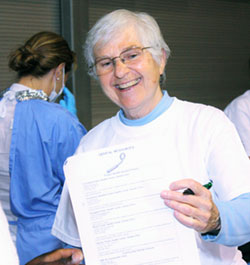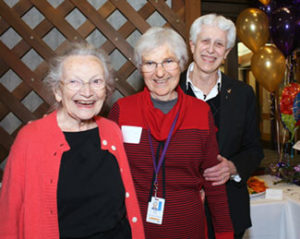
As founder of the UW Oral Health Collaborative, Professor Norma Wells, RDH, was for years one of our School’s most visible public faces across Washington State. Emerging in 1995, the Collaborative focused in its early years on oral health services and education with children and families in rural communities. Over time, it has reached thousands of people, including those in tribal, urban, migrant, veterans, disabled, senior, and homeless communities. Professor Wells, who graduated from our Dental Hygiene Class of 1958, retired at the end of 2014 as Associate Professor Emeritus in our Department of Oral Health Sciences. Here she talks about partnerships and how the Collaborative got its start.
Historically, UW Dental Hygiene undergraduate academic programs were noted for clinical skills, preventive services and community educational activities. Together with other agencies, we developed and carried out preventive dentistry clinical and educational programs among diverse and special populations, built clinics, and focused on partnerships. Further, it was common for the dental school to refer requests to my office. Then, in 1983, the Department of Dental Hygiene was eliminated and the Degree-Completion Program with its few students moved to another department. This reduced program capabilities to honor requests.
Drawing early membership from dental hygiene graduates as well as current students, the group became a first responder of sorts to the litany of incoming requests from the community that I fielded. I thought, “We need to do something more than what I can do from answering the phone and giving them resources.” Thus, the idea of a collaborative was born. As the UW Collaborative evolved, we became a hybrid of academia with grass-roots activism. The outcome was that we got really good at this – planning, delivering and building programs with partners throughout the state interested in promoting oral health and preventing dental diseases.
An early example is the partnership with GEAR UP (Gaining Early Awareness and Readiness for Undergraduate Programs), Heritage College (now Heritage University}, and Yakima Valley Community College.

Prior to this, I had gone to the UW Vice President for Learning and Technologies and said, “I could really use your help.” He listened and finally said, “I’m going to put you in touch with some people in the (Yakima) Valley.” One of those people was the Chair of Math and Science at Heritage University. I visited with her and said, “These are the types of things we do,” and one of the things was an event with the Yakima Community College. She said, “Well, I would like to be a part of this,” so our very first partners were with a private and public institution. She arranged to have a bus transport middle school children in her Saturday Science Club that went to Toppenish-area schools. They filled a bus with about 40 kids and with box lunches they drove from Toppenish to W. Brown Dental Hygiene Clinic, where we held a science fair with six hands-on dental-related activities.
We taught them to read an X-ray, to take an X-ray, to find microbes using a microscope, seal extracted teeth, and dissolve an egg to simulate tooth decay (demineralization) and fluoride effects – things of that nature. Let them do it themselves! Hands-on stuff, and they loved it.
From our initial start with the Little Tooth program – a puppet show, the Tooth and Wizard Academy youth, oral health lesson plans using the state Office of Public Instruction guidelines, and the UW Players, a youth theater arts group – we have honored requests from most counties in the state. Still, there is more to do, partnerships to develop and coalitions to support as we work toward improved oral health for people in our state.